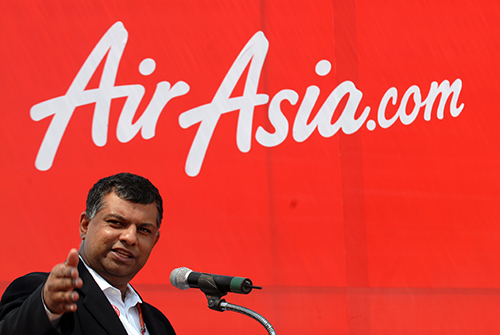Successful entrepreneur, brash self-promoter, ‘the Richard Branson of Asia’, F1 team owner – Tony Fernandes wears many hats. But after a heady decade of success, expansion and accolades, spent building his budget airline AirAsia into one of aviation’s biggest successes, recent events have brought this high-flier down to earth.
His long-haul unit AirAsia X is expected to stop flying the unprofitable London and Paris routes this month, the first serious setback to his fast-growing airline business.
Fernandes’ woes do not end there. AirAsia’s profits plunged by 50 percent last year to RM558 million, due to rising fuel costs and global uncertainty. Meanwhile, there are more low-cost competitors on the horizon, and the company also faces allegations of poor service and deceptive practices.
But despite the recent negative news, analysts believe his airlines’ refocus on Asia could strengthen Fernandes’s empire and keep it a step ahead of the competition.
“Their prospects remain very strong,” said Shukor Yusof, an aviation analyst with Standard & Poor’s in Singapore told AFP. He based this on healthy forward bookings and effective management.
“It is still the leading low-cost carrier in this part of the world and will be for some time yet,” he added.
Fernandes took over failing AirAsia in 2001 and, with a new motto “Now everyone can fly,” rebuilt it into Asia’s largest low-cost airline, catering to the aspirations of the emerging middle class in the region.
He spread routes across Southeast Asia, and the launch of AirAsia X in 2007 extended his network’s reach to China, India and later Europe.
But those days of constant expansion are history for now. AirAsia X’s flights to Mumbai were dropped in January and those to Delhi stop in March.
Analysts said the group, which currently serves about 80 cities across 20 countries, has reached the limits of the low-cost airline model.
“What AirAsia X has found out is that once flights get up to nine, ten hours or more, you struggle to make money with the low-cost model,” said Brendan Sobie of the Centre for Asia Pacific Aviation told AFP.
He said Fernandes’ European foray was useful for marketing purposes. Fernandes, who already owned the Caterham Formula One team, bought English Premier League team Queens Park Rangers last year. He promptly advertised AirAsia’s logo across player jerseys, building up brand recognition.
“People in Europe know about (AirAsia) now. It was good for marketing. Now, when they come to Asia they know they can fly around on AirAsia,” said Sobie.
But the routes pullback will result in a renewed focus on the profitable Asian market, concentrating on the core markets of Southeast Asia, Australia, China, Taiwan, Japan, and South Korea.
AirAsia continues with routes up to four hours’ flying time from KL, while AirAsia X will now focus on medium-haul flights within Asia.
Budget air travel is estimated to make up about 15 percent of passenger traffic in Southeast Asia, but by 2020 this could reach 35 percent.
According to Boeing’s current forecast, the region will need 2,750 jet aircraft between 2011–30, at a total price of RM1.2 trillion. Most will be single-aisle planes like the Boeing 737 that is the workhorse of budget carriers.
A rash of low-cost airlines has sprung up, seeking to emulate AirAsia’s success. Competitors include Singapore Airlines’ Scoot, the Philippines’ Cebu Pacific Air, and Indonesia’s Lion Air. But with AirAsia having the first-mover advantage, these new entrants could struggle against a refocused AirAsia.
For instance, AirAsia X will fly a new route to Sydney from April 2, several months before Scoot makes its maiden flight to the Australian city.
But it won’t be easy for the incumbent either.
Analysts said AirAsia’s share swap and partnership deal with loss-making Malaysia Airlines (MAS) could turn out to be a “drag” on its profitability.
AirAsia also faces persistent passenger complaints over sudden cancellations of flights and unexpected booking charges.
Australian regulators filed a lawsuit in January alleging that AirAsia concealed the final price of flights on its website. The company said it has taken “corrective action.”
47-year old Fernandes also has a colourful history of making disparaging comments against competitors. When Singapore Airlines announced its plans for Scoot, he insisted they had “copied” the idea from his business.
Fernandes tweeted, “Singapore Airlines to set up a long haul low cost carrier. Hahahaha. Déjà vu.”
It’s not surprising the media calls him the Richard Branson of Asia. Fernandes in fact knows Branson well, having working for Virgin Records for three years in London in the late 1980s.
One apocryphal story about their friendship perhaps sums up Fernandes best. Branson owns another rookie F1 team, Virgin Racing, and the two F1 owners took a friendly bet in 2010 that whichever team was slower on the track, the losing owner would serve guests on the winner’s airline.
In the end Branson lost the bet, and jokingly accepted that he would dress up as a stewardess on an AirAsia flight.
Branson should consider himself lucky. After all, given Fernandes’ tenacity, Branson could well have found himself labelled the ‘Tony Fernandes of Europe’.

